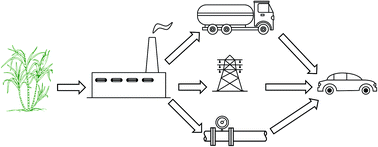Assessing the sugarcane bagasse and straw as a biofuel to propel light vehicles†
Abstract
Sugarcane bagasse and straw are the residues from sugarcane production. They can be used to produce electricity, second-generation ethanol, and biogas. These three kinds of fuel are energy carriers that can be used to propel light vehicles. Thus, we assessed the use of these two residues as a primary fuel to propel light vehicles. For this assessment, this article takes into account, for the same amount of primary energy, the distance one can drive, the emission of CO2, the water usage, the expenditure to build the facilities, and some qualitative indicators, such as health and handleability. It is found that bringing straw from the field increases the production of biofuels and mitigates the environmental impact. Considering the different energy carriers (ethanol, electricity, and biogas), it is possible to conclude that depending on the criteria used to analyze these energy carriers, one carrier would be preferred to another. For example, taking into account the return on the investment, electricity would be the least preferable one, while analyzing health, electricity would be the most preferable one. The uncertainty associated with the analysis is captured using the Monte Carlo approach. Thus, some indicators, such as the distance one can drive and the CO2 emissions, show that they depend on the uncertainty associated with the conversion efficiency of the different processes and the vehicle mileage-rate.



 Please wait while we load your content...
Please wait while we load your content...